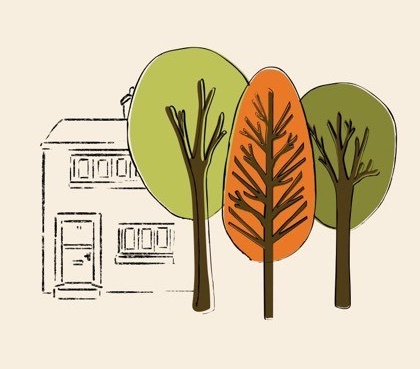The Cornmill: Difference between revisions
PhilRadford (talk | contribs) No edit summary |
PhilRadford (talk | contribs) No edit summary Tag: Manual revert |
||
| Line 4: | Line 4: | ||
The Luddenden Cornmills were owned by The Murgatroyd family for the majority of their life, the first record of a mill here was from 1274. There is a lot of published information about the early years of the Luddenden Mills (such as https://familymurgatroyd.com/mill.htm) | The Luddenden Cornmills were owned by The Murgatroyd family for the majority of their life, the first record of a mill here was from 1274. There is a lot of published information about the early years of the Luddenden Mills (such as https://familymurgatroyd.com/mill.htm) | ||
Grinding Corn was the earliest record for the use of water power in the Luddenden Valley, but there were many uses for this valuable resource. The valley had at least eleven water mills with a range of uses. [[ | Grinding Corn was the earliest record for the use of water power in the Luddenden Valley, but there were many uses for this valuable resource. The valley had at least eleven water mills with a range of uses. [[Water Power in Luddenden Dean]] | ||
==THE 1854 AUCTION== | ==THE 1854 AUCTION== | ||
Revision as of 12:04, 24 January 2025
The Early History of The Luddenden Cornmill
The Luddenden Cornmills were owned by The Murgatroyd family for the majority of their life, the first record of a mill here was from 1274. There is a lot of published information about the early years of the Luddenden Mills (such as https://familymurgatroyd.com/mill.htm)
Grinding Corn was the earliest record for the use of water power in the Luddenden Valley, but there were many uses for this valuable resource. The valley had at least eleven water mills with a range of uses. Water Power in Luddenden Dean
THE 1854 AUCTION
The last Murgatroyds to run the mills were brothers Hartley (1797-1865) and John (1799-1873).
The brother's seem to have got into some financial difficulties and had to sell a lot of property in Luddenden and the surrounding valley including the Cornmills.
Twenty lots were put up for auction at the Murgatroyd Arms on 19th July 1854. Neither of the Mills sold on the day, but both change hands shortly afterwards.
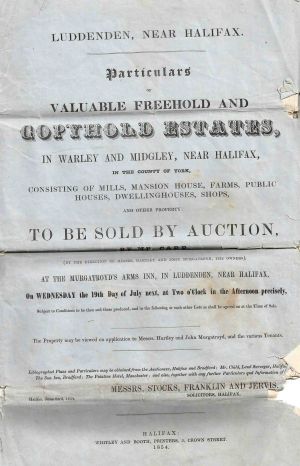
The brochure for the auction included two maps, the first showed the lots for sale on the hills surrounding the village.
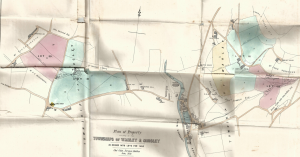
The second map shows the village lots.
On this second map, Lot 13 is Upper mill and includes the mill pond and a plot of land and sluices next to the weir. The land that the mill occupied is now housing (High Street Court).
The map shows the function of each of the buildings in the mill. The majority of the mill was being used for malting barley ready for making beer.
An accompanying document also describes the property;
All that valuable Corn Mill called "Upper Mill" situate in Luddenden, with the Malt Kiln, Warehouses, Stabling for 18 Horses, Wagon and Cart sheds, Gighouse, Joiner's Shop, Paved Yards and Outbuildings. Also the Reservoir behind the same, containing 2,008 superficial square yards, with the Water Wheel and the entire Fall of the Luddenden Brook, being about 30 horsepower. And also the Weir and Dam-stones across the Brook, Cloughs, and the Plot of Ground appropriate thereto, together with the use of the head Goit and the Tail Goits.' 'The Mill is five stories High, and attic, and the whole of the premises have been recently rearranged. The water wheel is a new iron one, 27 feet in diameter and nine on the breast.
The wheel generated about 30 horsepower.
Lot 14 is Lower mill. The three stoery building now know as The Cornmill is the only surviving part of the mill shown on this map. The two storey part of today's Cornmill was a later addition (but built before 1890).
On the map, you can see the head and tail goits that fed the water wheel. You can see that there is a boiler room and a chimney (so this mill had steam power at this date). There are cottages to the south side of the mill and a building labelled as Counting House adjacent to the bridge.
The land of Lot 14 is labelled as 'Holme' and it extends as far as the next weir on the brook. This whole area is now occupied by Blue Bell Walk. The field above Lower Mill, Lot 15 is labelled as 'Bank'. The Eastwood family bought both Lot 14 and 15 in about 1856 and immediately started to convert and extend this mill into a sizable woollen mill.
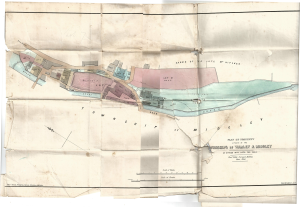
Below is a copy of the previous map, highlighting Lot 13. This hand traced copy is part of a document drawn up in 1856 when Upper Mill was sold by Hartley and John Murgatroyd to the Thompsons and their partner, Joseph Starkey (who bought a third share in the mill).
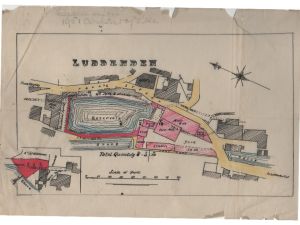
The Thompson Family at Upper Mill
In 1856, Upper Mill was Sold to:
- George Thompson (b.1786), one third share.
- Joseph Starkey, one third share.
- Robert Thompson (1810-1875), one sixth share.
- William Henry Thompson (b.1817), one sixth share.
Robert and William Henry Thompson were brothers.
George Thompson (b.1786), their father had an established Corn Milling business and already owned one of the Mills at Luddendenfoot. He was living at Middle foot in 1841.
Robert Thompson (1810-1875)
Robert Thompson was baptised at a Methodist Chapel in Luddenden on 13th August 1810. He was living at Upper Foot (this is the area around Burnley Road heading towards Brierley) in 1851 working as a Corn Miller. After the purchase of Upper Mill, George and his family moved into Chapel House (another Purchase in the 1854 Auction), the house that John Murgatroyd had lived in. At this stage he is employing 2 men according to the 1861 census.
In 1863, Robert bought William Henry's share in the mill for £1000 (to become the sole owner of Upper Mill?) (MISC:905/323 –West Yorkshire Archive- https://www.catalogue.wyjs.org.uk/CalmView/Record.aspx?src=CalmView.Catalog&id=CC01688%2f9%2f3&pos=1)
By 1871, Robert and his family had moved to Carrfield (which was built for them?) and he is employing 11 men at Upper Mill.
Robert dies in 1875 aged 65, his wife took ownership of the business which their son Arthur ran. The business continues to grow and in 1881 it employed 22 men and 2 boys.
But then, the family suffers some set backs, both Robert and Hannah's sons died. Arthur died in 1899 and his younger brother George had died in 1882. George's only son Frederick William also died in 1894.
All of this is recorded on the family memorial in Luddenden Cemetery, the monument, a tall obelisk with a pink granite top is easily located and is situated to the north side of the chapel of rest.
This left the family with a big problem as there re no males left to succeed Arthur, the Upper Mill being inherited by Robert's two daughters, Mary and Julia.
Whether through a fall in demand for milled oats and wheat or through a lack of leadership, the mill ceased to produce flour in the early 1890's and the Thompson sisters start to rent out sections of Upper Mill to people starting up new business ventures or for businesses requiring additional space for expansion. So the site becomes an industrial estate.
William Henry Thompson (b.1817)
Meanwhile William Henry moves into Cooper House (in 1861 census) and then to Stansfield Hall (John Naylor Lane, Luddendenfoot).
He continues to be a Corn Miller after selling his share in Upper Mill. He focuses his efforts on his own Cornmill at Luddendenfoot. This may have been Denholme Mill (on the south side of Burnley Road heading towards Cooperfield overlooking the canal) or may have been on Luddendenbrook near The Weaver's pub.
Historically, there were two fulling mills at Luddendenfoot one on either side of Luddenden Brook, one was where The Weaver's pub is situated and one directly opposite on land now occupied by Mill Stream Drive. These may also have been Cornmills at some stage during their history.
The 1871 census shows that he is employing 16 men and 2 boys.

These invoices remind us that the staple crop in the Pennines was Oats, not wheat, the bulk of these two orders being oatmeal (what did the Cornmills Produce?)
